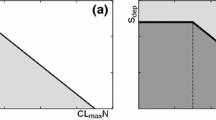Abstract
This paper describes an assessment of ecological standards for eutrophication and desiccation using the ecotoxicological approach of standard setting. In ecotoxicological risk assessment single-species toxicity data, such as No Observed Effect Concentration (NOEC), are used to extrapolate maximum tolerable concentrations (MTC) which protect 95% of the ecosystem's species. In our approach single-species data consist of the species-response function for both nutrient availability and soil moisture. These data were used to calculate the maximum levels at which 95% of the plant species are protected. A case study, using data on 275 plant species of usable grasslands in the province of South Holland, has been carried out. Ecological standards are calculated for maximum nitrogen load and changes in groundwater level. The influence of nitrogen limitation and moisture shortage on the 95% species protection level is considered. Differences in methodology between our approach and the assessment of ecological standards for micro-pollutants and critical loads are evaluated.
Similar content being viewed by others
References
Aldenberg, T. and Slob, W.: 1993, Ecotox. Environm. Safety 25, 48–63.
Bobbink, R., Boxman, D., Fremstad, E., Heil, G., Houdijk, A. and Roelofs, J.: 1992, Critical loads for nitrogen eutrophication of tessestrial and wetland ecosystems based upon changes in vegetation and fauna, in P. Grennfelt and Thornelof, E. (eds.), Critical loads for nitrogen. Report from a workshop held at Lokeberg, Sweden 6–10 apil 1992, Nordic Council of Ministers, Copenhagen.
CBS: unpublished data 1991, Annual agricultural statistics. Centraal Bureau voor de statistiek, The Hague.
Clausman, P. H. M. A., Den Held, A. J., Jalink, L. M. and Runhaar, J.: 1987, Milieuindicaties van vegetaties (TOEWIJS). Dienst Ruimte en Groen van de Provincie Zuid-Holland, Den Haag, The Netherlands, report no. deelrapport 2. 83 pp.
De Kruijf, H.A.M.: 1991, Comp. Biochem. Physiol. 100C, 291–299.
De Vries, W.: 1991, methodologies for the assessment and mapping of critical loads and of the impact of abatement strategies on forest soils. Winand Staring Centre, Wageningen, The Netherlands, report no. 46. 109 pp.
De Vries, W. and Heij, G. J.: 1991, Critical loads and critical levels for the environmental effects of air pollutants, in G. J. Heij and Schnieder, T. (eds.), Acidification research in the Netherlands, Elsevier, Amsterdam, pp. 205–214.
De Vries, W., Posch, M. and Kamari, J.: 1989, WASP48, 349–390.
Ellenberg, H.: 1979, Scipta Geobotanica 9, 1–122.
EPA: 1990, Reducing risk: setting priorities and strategies for environmental protection. Report of the Science Advisory Board: Relative Risk Reduction Strategies Committee. US-EPA, Washington D.C.
Gremmen, N. J. M., Reijnen, M. J. S. M., Wiertz, J. and Wirdum, G. v.: 1990, J. Environ. Manage. 31, 143–155.
Hutchinson, G. E.: 1957, Cold Spring Harbor Symp. Quant. Biol. 20, 415–427.
Jongman, R. H. G., Ter Braak, C. J. F. and Van Tongeren, O. F. R.: 1987, Data analysis in community and landscape ecology, Pudoc, Wageningen, The Netherlands, 299 pp.
Kros, H., De Vries, W., Janssen, P. H. M. and Bak, C. I.: 1993, WASP 66, 29–58.
Latour, J. B. and Reiling, R.: 1993, Sci. Tot. Environ, Suppl., 1513–1526.
Roos, R. and Vintgens, V.: 1991, Het milieu van de natuur. Herkennen van verzuring, vermesting en verdroging, Stichting Natuur en Milieu, Utrecht, 240 pp.
Runhaar, J.: 1989, Landschap 6, 129–147.
Shelford, V. E.: 1913, Animal Communities in Temperate America, University of Chicago Press, Chicago.
Slooff, W.: 1992, RIVM Guidance Document: Ecotoxicological effect assessment. Deriving Maximum tolerable concentrations from single-species toxicity data. RIVM, Bilthoven, The Netherlands, report no. 719102018. 49 pp.
Slooff, W., Cleven, R. F. M. J., Janus, J. A. and Ros, J. P. M.: 1989, Integrated criteria document copper. RIVM, Bilthoven, report no. 758474009. 147 pp.
Slooff, W. and Tingey, D. T.: 1991, Comparison of risks for ecosystems and materials, U.S.-Dutch Workshop Comparative Risk Analysis, Seatle, Washington D.C. June 1991.
Snedecor, G. W. and Cochran, W. G.: 1989, Statistical methods, lowa State University Press, Ames, Iowa, 503 pp.
Stephan, C. E., Mount, D. L., Hansen, D. J., Genrile, J. H., Chapman, G. A. and Brungs, W. A.: 1985, Guidelines for deriving numerical national water quality criteria for the protection of aquatic organisms and their uses. US-EPA, Washington DC.
Ter Braak, C. J. and Gremmen, N. J. M.: 1987, Vegetatio 69, 79–87.
Van der Eerden, L. J., Dueck, T. A., Posthumus, A.C. and Tonneijck, A. E. G.: 1992, Assessment of critical levels for air pollutant effects on vegetation: some considerations and a case study on NH3, UNECE Workshop on Critical Levels, Egham, U.K., 23–26 March 1992.
Van Straalen, N. M. and Verkleij, J. A. C.: 1991, Leerboekoecotoxicologie, VU uitgeverij, Amsterdam. 422 pp.
Van Strien, A., Maintenance of plant species diversity on dairy farms, Ph.D. thesis, Kanters BV, Alblasserdam, The Netherlands, 1991.
Wagner, C. and Lokke, H.: 1991, Wat. Res. 25, 1237–1242.
Wiertz, J., Van Dijk, J. and Latour, J. B.: 1992, De MOVE-vegetatie Module: De kans op voorkomen van 700 plantesoorten als functie van vocht, pH, nutrienten en zout. IBN/RIVM, Wageningen/Bilthoven, report no. IBN 92/24; RIVM 711901006. 138 pp.
Wolff, W. J., Latour. J. B. and Reiling, R.: 1991, Biologische voorraden, in R. Maas (ed.), De Tweede Nationale Milieuverkenningen 1990–2010, Samsom H.D. Tjeenk Willink bv. Alphen aan de Rijn, The Netherlands, pp. 118–127.
Author information
Authors and Affiliations
Rights and permissions
About this article
Cite this article
Latour, J.B., Reiling, R. & Slooff, W. Ecological standards for eutrophication and desiccation: Perspectives for a risk assessment. Water Air Soil Pollut 78, 265–277 (1994). https://doi.org/10.1007/BF00483036
Received:
Accepted:
Issue Date:
DOI: https://doi.org/10.1007/BF00483036




